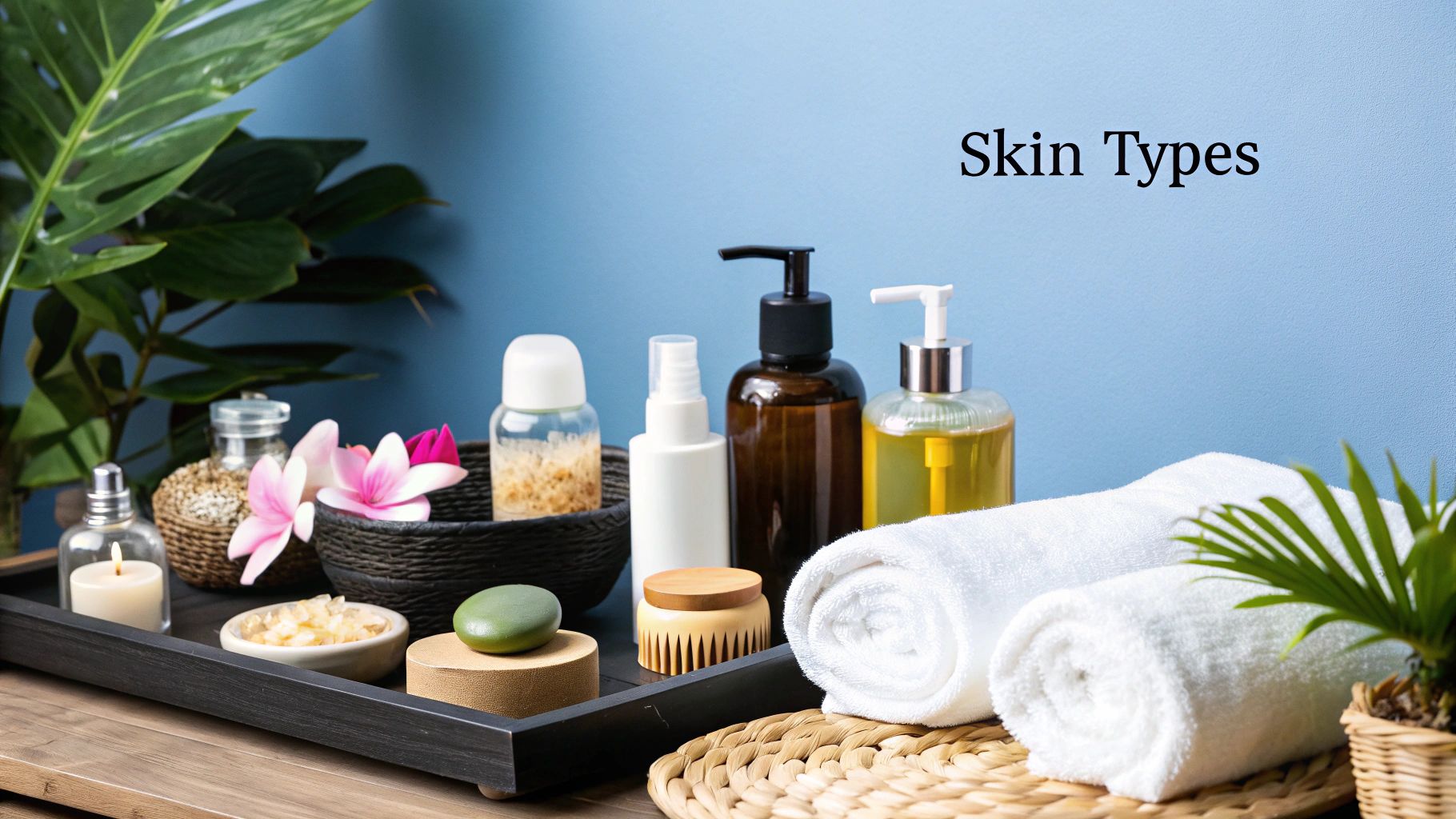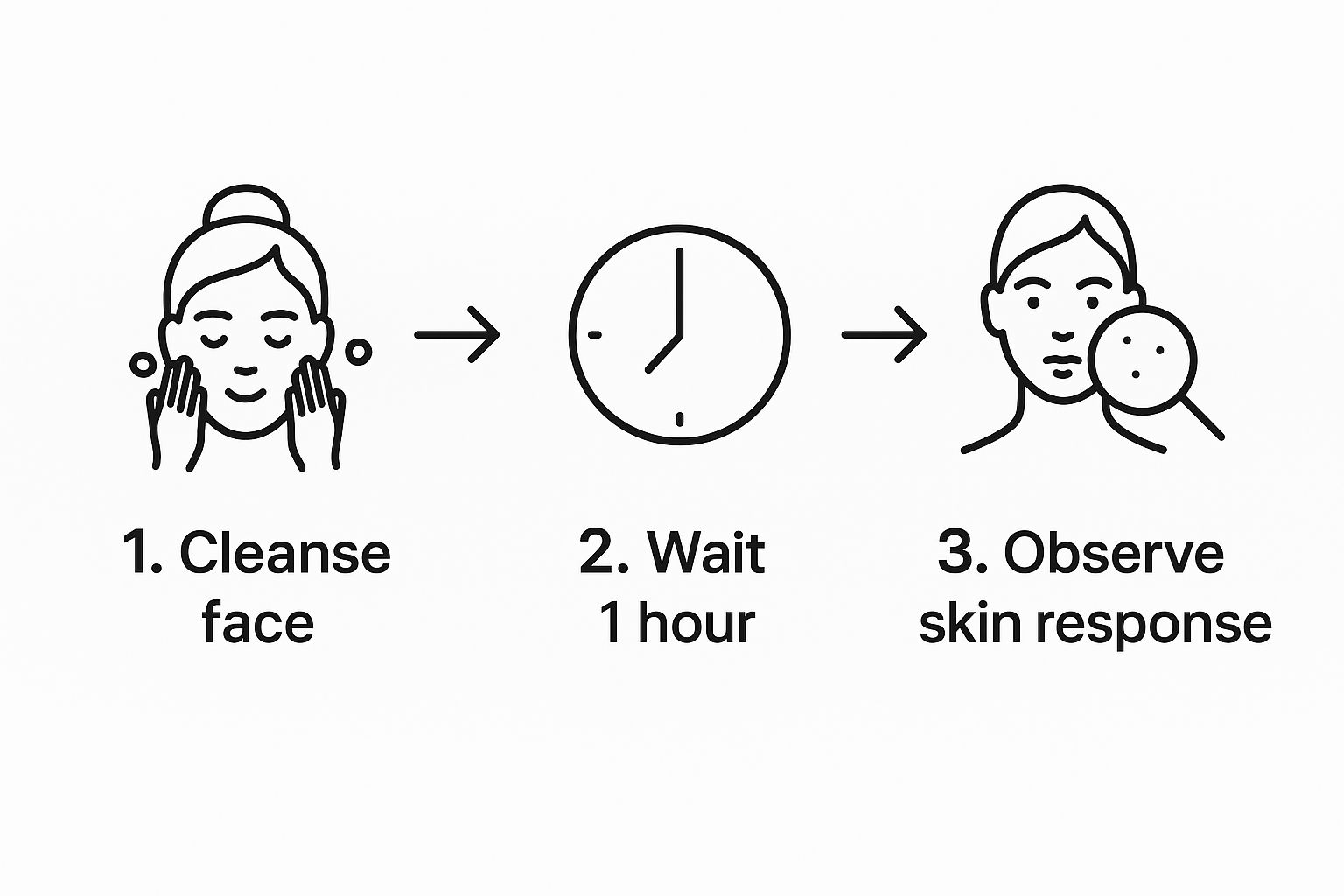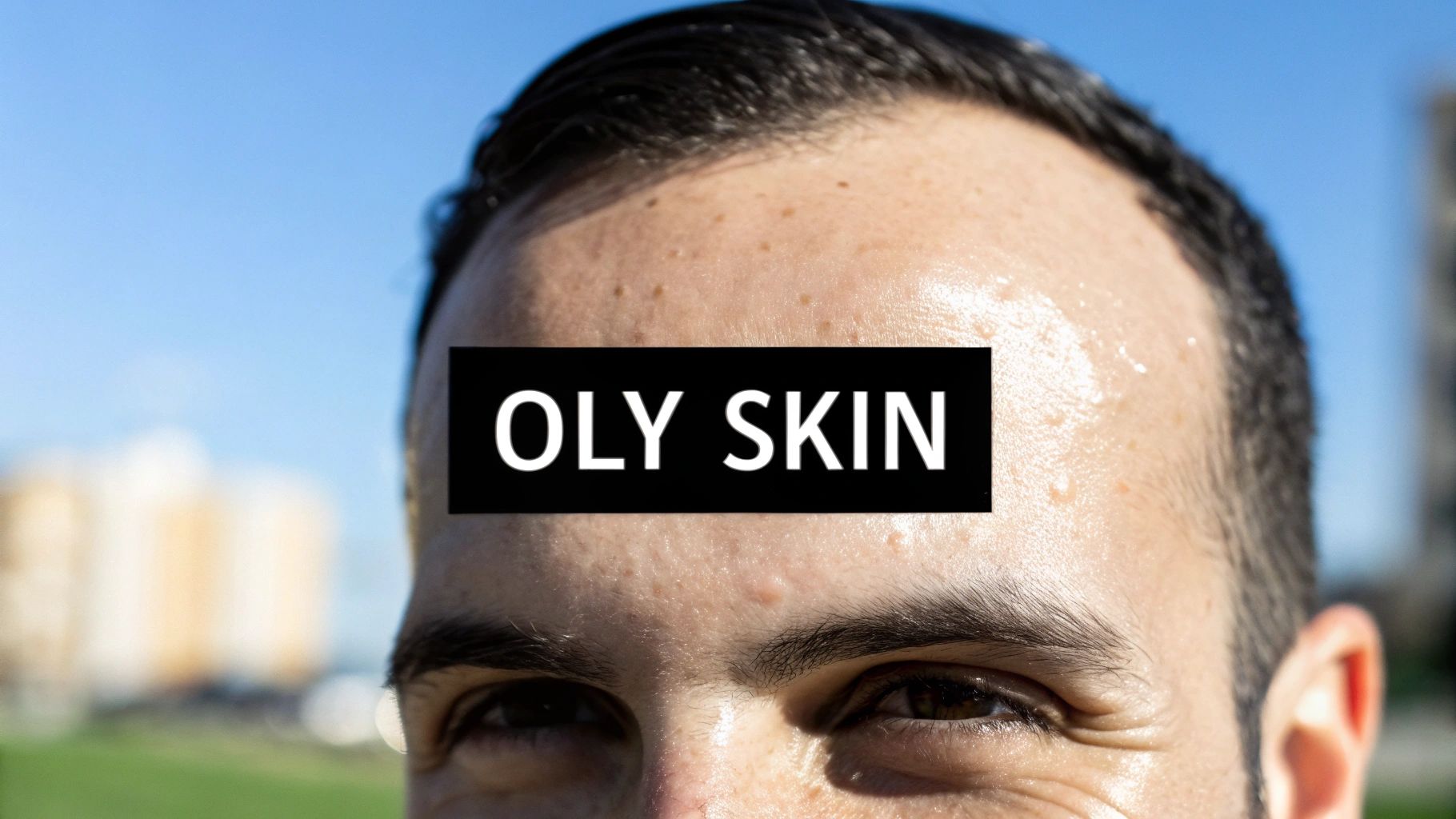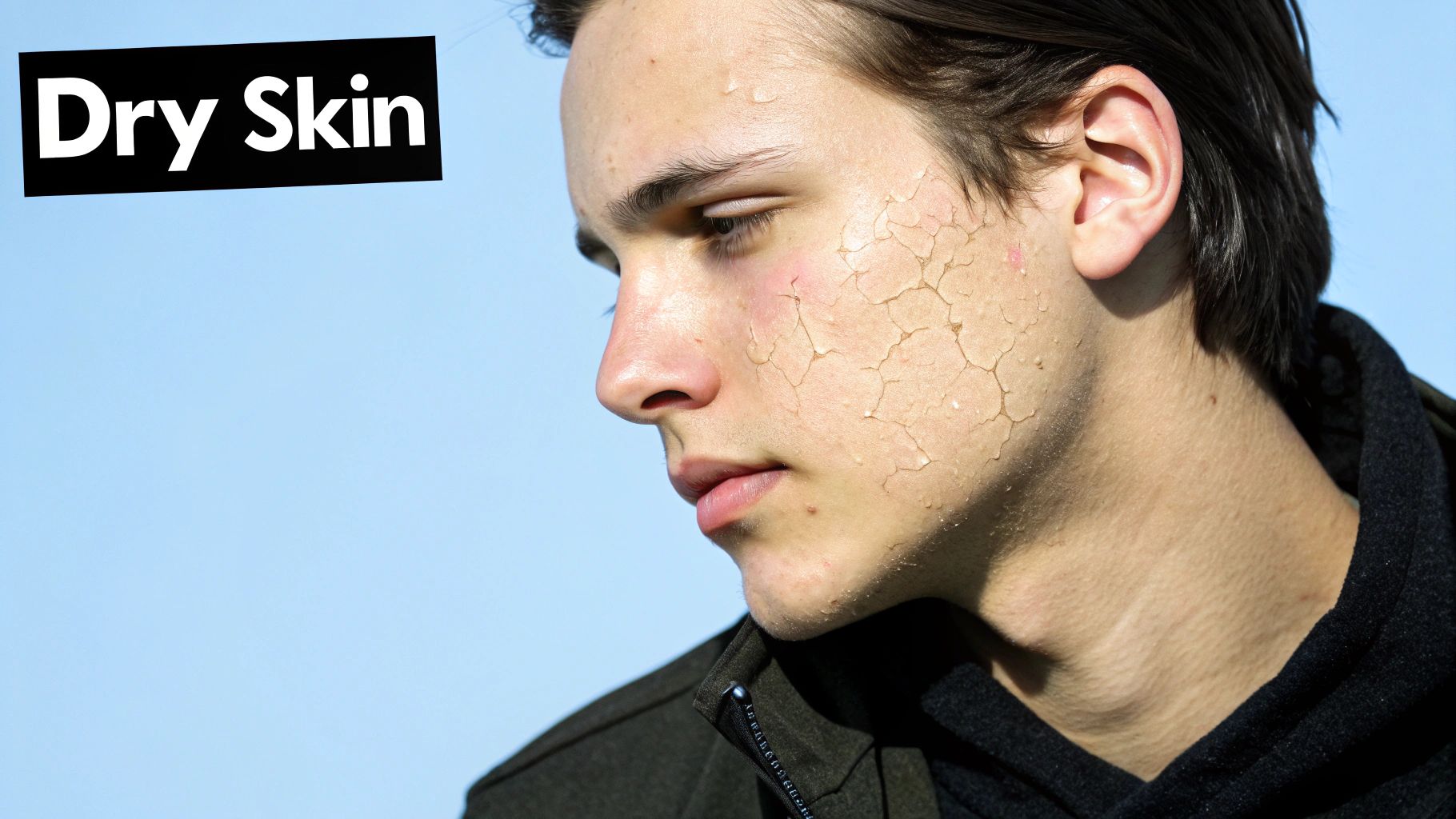Jan Elvis
04.10.2025

Jan Elvis
04.10.2025
Ever wonder why that "holy grail" moisturizer everyone raves about made you break out? Or why a certain cleanser leaves your face feeling tight and stripped? It's a super common story, and the culprit is almost always the same: a mismatch between the product and your skin type.
Figuring out your skin's unique personality is the absolute first step toward building a skincare routine that genuinely works. It’s what takes you from blindly guessing in the beauty aisle to making smart, intentional choices for your skin.
Think of it this way: you wouldn't fight an oil slick with more oil, right? The same logic applies to your face. Once you understand what your skin is naturally doing, you can start working with it, not against it.
This is the key to trading a bathroom cabinet full of half-used, disappointing products for a simple, effective lineup that leaves your skin happy and balanced.
When you know your skin type, you stop just buying products and start investing in your skin's health. It’s the most basic, yet most powerful, piece of the puzzle.
Ultimately, this knowledge is what helps you find those true Main Character products that feel like they were made just for you. The result? Fewer breakouts, less irritation, and a complexion that just feels good. Let's walk through a couple of dead-simple tests you can do right at home to figure it all out.

One of the most trusted ways to get to know your skin doesn't cost a penny. It's called the bare-face method, a straightforward test that lets your skin tell you exactly what it needs. All it takes is a gentle cleanser and a little bit of patience.
Start by washing your face with a mild cleanser. You want to clear away any daily grime or oil without completely stripping your skin, so reach for something gentle. Pat your face dry with a clean towel, and then—here’s the crucial part—leave it completely bare. No moisturizer, no serum, no toner. Nothing.
Now, just let your skin breathe and do its thing for about 30 to 60 minutes. After that time is up, head to a mirror and pay close attention to how your face looks and, just as importantly, how it feels. The clues will be pretty clear.
This simple observation technique is a cornerstone of dermatology. It’s similar in principle to professional tools like the Fitzpatrick Skin Phototype classification, which was created to categorize skin based on how it reacts to things like sunlight. Professionals use this scale to recommend the right sun protection and treatments.
While professional scales analyze UV response, this at-home test zeroes in on your skin’s natural oil production. It's a surprisingly personal and effective way to understand your baseline.
One major study of 3,386 people revealed just how diverse skin types are, with 25.0% falling into Type V and 18.8% into Type VI. You can explore the full research about these population-based findings to see the data. This simple test gives you that same kind of direct insight, helping you build a skincare routine that actually works.
If the bare-face method feels a little too vague, blotting sheets give you a much more visual, in-your-face answer. This is my go-to recommendation for anyone who wants a quick, undeniable snapshot of their skin's oil production. It's incredibly simple.
For the best results, try this test around midday. That’s usually when your skin’s oil glands have kicked into high gear, so you'll get a true sense of what you're working with. Just take a clean blotting paper and gently press it against different spots on your face—your forehead, nose, cheeks, and chin. The key is to press, not rub.
After pressing the sheet to each area, hold it up to a light source. The amount of oil on the paper tells you everything you need to know.
This visual guide breaks down the core steps for figuring out your skin type at home, covering both the bare-face and blotting methods.

As you can see, the basic idea is always the same: cleanse, wait, and then observe. It’s a straightforward process that takes the guesswork out of the equation.
The blotting sheet test is perfect for anyone who prefers concrete evidence. It’s a hands-on approach that turns that abstract feeling of “shininess” into a tangible result you can see right in front of you. This makes it a fantastic alternative if you find the clues from the bare-face method a bit too subtle to interpret confidently.

Okay, you’ve done the at-home tests. Now it’s time for the fun part: decoding what your skin is telling you. Knowing your skin type’s core traits is the secret to picking products that actually work with your skin, not against it.
One quick but important distinction before we dive in: dry skin is a type that naturally produces less oil, while dehydrated skin is a condition where it lacks water. Any skin type can become dehydrated, so don’t get the two confused!
Let's break down what your test results probably look and feel like. Think of these as the fundamental starting points for building your perfect skincare lineup.
A huge mistake I see people make is attacking oily skin with harsh, stripping cleansers. This just damages the skin’s protective barrier, tricking it into producing even more oil to compensate. It’s a vicious cycle that only leads to more shine and breakouts.
Sometimes a quick visual comparison is all you need. Here’s a simple chart to help you pinpoint where your skin fits in.
| Skin Type | How It Feels | How It Looks | Key Concern |
|---|---|---|---|
| Normal | Balanced, comfortable, neither tight nor slick. | Smooth texture, small pores, radiant. | Maintenance & Prevention |
| Oily | Greasy or slick, especially midday. | Shiny, enlarged pores, prone to breakouts. | Oil & Blemish Control |
| Dry | Tight, itchy, rough, or flaky. | Dull, may have fine lines or red patches. | Hydration & Moisture |
| Combination | Oily in the T-zone, dry/normal elsewhere. | Shiny forehead/nose, flaky cheeks. | Balancing Oil & Dryness |
| Sensitive | Stinging, burning, itchy, or tight. | Red, blotchy, prone to rashes or bumps. | Soothing & Reducing Irritation |
This table gives you a great starting point for understanding your skin's unique behavior and what it needs most.
It's also worth remembering that these categories are just a guide. Modern research is constantly refining how we classify skin. For instance, datasets like the International Skin Spectra Archive collect over 15,000 skin color records from people worldwide to measure skin characteristics far beyond what the eye can see.
This kind of data shows just how much skin can vary between different ethnic groups and why a one-size-fits-all approach to skincare is bound to fail. For a deeper dive, this resource on what are the 5 skin types is a great read.
Once you have a solid idea of your type, you can start making smart choices. For example, if you're trying to balance your skin's pH and prep it for other products, exploring the best skin toners for your specific needs is a fantastic next step.

So, you’ve done the tests and you think you have the answer to "how can you tell your skin type." But here’s something you need to know: that classification isn't set in stone. Think of your skin as a living, breathing organ that's constantly reacting to what's happening both inside your body and out in the world.
Your genetics definitely lay the groundwork for how your skin generally behaves. That's your baseline. But it's far from the only thing calling the shots.
Your skin's behavior today isn't necessarily its behavior next month or next year. Understanding the triggers that cause it to shift is the key to maintaining balance long-term.
What you're born with is a huge piece of the puzzle, no doubt. Our evolutionary history has a massive impact on skin characteristics. For example, specific genetic variants like SLC24A5 are responsible for major differences in skin pigmentation and type across the globe, which helps explain why some populations are naturally more prone to oiliness or dryness. This genetic blueprint sets the stage, but it doesn't write the whole script.
Beyond your DNA, a handful of powerful factors can temporarily—or even permanently—change your skin's condition. Knowing what they are means you can adjust your skincare game before problems start.
Climate and Seasons: Ever feel like an oil slick during a humid summer, only to have your skin feel tight and cracked in the winter? That’s your environment at work. Big swings in humidity and temperature directly mess with your skin's moisture and oil production.
Hormonal Changes: Stress, your monthly cycle, and major life events can all cause hormonal fluctuations. These shifts can send your oil glands into overdrive or, conversely, lead to sudden dryness and sensitivity out of nowhere.
Diet and Lifestyle: It's a cliché for a reason: you are what you eat. A diet high in sugar can spark inflammation, while things like chronic stress and not getting enough sleep can weaken your skin's protective barrier, leaving it vulnerable to irritation.
Recognizing these influences is crucial because it explains why that "perfect" routine might suddenly stop working. You might find yourself needing a much richer face moisturizer for winter to fight off the cold, dry air, even if your skin is normally pretty balanced the rest of the year.
Alright, you've done the detective work and figured out what your skin is trying to tell you. Now for the fun part: putting that knowledge to use. Building a routine isn't about collecting a shelf full of products; it's about giving your skin exactly what it needs with a few solid essentials.
The best place to start is with the classic three-step approach: cleanse, moisturize, and protect. This simple trio is the foundation of any good skincare game. Once you nail this, you can confidently read product labels and pick ingredients that will actually work with your skin, not against it.
Think of these three products as your non-negotiables. The goal is to find formulas with ingredients that match your skin's unique personality.
Oily Skin: You'll want a lightweight gel cleanser, maybe one with a little salicylic acid, to keep oil in check without that tight, stripped feeling. An oil-free moisturizer is your best friend here—it hydrates without adding extra shine or clogging pores.
Dry Skin: Go for a creamy, gentle cleanser that won’t suck the life out of your skin. Pair it with a richer moisturizer loaded with stuff like ceramides or hyaluronic acid to help lock in moisture and repair your skin’s barrier.
Combination Skin: It’s all about finding that happy medium. A gentle foaming cleanser usually works well everywhere. You might even play around with using a lighter moisturizer on your T-zone and something a bit more hydrating on your cheeks.
Sensitive Skin: Your mantra is "less is more." Look for fragrance-free products with calming ingredients. A simple milky cleanser and a no-fuss moisturizer with niacinamide can do wonders to soothe redness and irritation.
Knowing your skin's profile is a total game-changer. It's not just about buying daily products; it's about making informed decisions on everything, including whether treatments like microneedling or a chemical peel are a smart move for your specific goals.
Getting this simple routine down is the first real step. If you want to dive deeper, our complete guide to a skincare routine for men walks you through everything. This is about creating a simple, sustainable habit that makes you feel good in your own skin.
So, you've done the tests, but maybe you're still a little unsure. That's totally okay. Think of figuring out your skin as an ongoing conversation, not a final verdict you get one time.
Let's dig into a couple of the most common questions that pop up when you're just starting to decode what your skin is trying to tell you.
Nope, definitely not. While your genetic blueprint gives you a starting point, your skin is constantly reacting to your life and environment. It's anything but static.
Major hormonal shifts, like puberty or even just a really stressful month, can send your oil glands into overdrive. And as we get older, it's pretty common for skin to lean drier than it used to.
Because of all this, it's smart to check in with your skin every few months. This way, you can be sure the products you're using are actually what your skin needs today, not what it needed six months ago.
This is a big one, and it trips up so many people. Nailing this distinction is one of the most important things you can do to calm down angry, irritated skin.
Sensitive skin is usually something you're born with. It's your skin's built-in personality—it's just naturally more reactive to new products, fragrance, or environmental stuff. You might be prone to issues like rosacea, eczema, or persistent redness.
Sensitized skin, on the other hand, is a temporary state. It's not a skin type but a condition caused by something external. Anyone, even someone with the toughest, oiliest skin, can get it. Usually, it’s a sign that you’ve over-exfoliated, used a product that was way too harsh, or spent a little too much time in the sun without protection.
Here's the good news: sensitized skin is completely fixable. By stripping your routine back to the gentle, soothing basics and focusing on ingredients that repair your skin's barrier, you can nurse it back to health.
Knowing the difference helps you react the right way. Instead of throwing out your entire routine because you think your skin type has changed overnight, you can pinpoint the real problem and make a targeted fix to get things back on track.
Ready to build a routine that truly gets you? Main Character offers premium care products designed to help you look and feel your best. Start your self-care journey and find the perfect match for your skin.